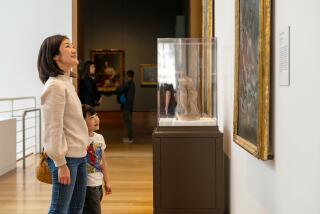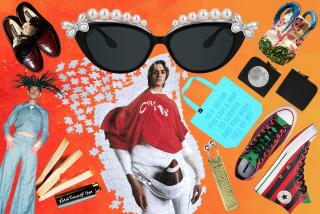Art preview: An ancient ‘bill of human rights’ at the Getty Villa
“I am Cyrus, king of the universe, the great king, the powerful king, king of Babylon, king of Sumer and Akkad, king of the four quarters of the world....”
So says the wedge-shaped cuneiform script on the little Cyrus Cylinder, one of the most celebrated discoveries from the ancient world. Obviously, Cyrus was no shrinking violet.
FOR THE RECORD:
Fall Arts Preview art exhibitions: An article in the Sept. 15 Arts & Books section about fall art exhibitions included incorrect information. The Huntington’s “Face to Face: Flanders, Florence, and Renaissance Painting” is not the first exhibition of its kind. It was inspired by a 2008 exhibition presented at the Palazzo Pitti in Florence. The paintings “Portrait of Philippe de Croy” and “Virgin and Child” by Flemish artist Rogier van der Weyden are not being displayed together for the first time in the U.S. They were shown together at an exhibition at the National Gallery of Art in 2006. The Huntington exhibition will be the first time they will be seen together in the Los Angeles area. In addition, the California African American Museum’s exhibition “Soul Stirring: African American Self-Taught Artists from the South” has artworks that date from the 1950s, not the 1970s. The late artist Sam Doyle descended from slavery, but neither of his parents were slaves.
CHEATSHEET: Fall arts preview 2013
Dug up in 1879 in the foundations of a ruined Mesopotamian temple by an excavation team working for the British Museum, where the object is permanently housed, the 4-by-9-inch clay cylinder records a pivotal episode in world history.
More than 2,500 years ago, Persian conqueror Cyrus the Great established a centralized government for a vast empire that encompassed all of the ancient Near East and parts of Central Asia.
The cylinder is a cultural document, more than a conventional work of art. But the impact is profound for what it reveals about literature, religion, politics, art and virtually every aspect of ancient society. Partly its narrative is an adventure story of the conquest of Babylon. More important, it also represents a monumental cultural shift.
ART: Can you guess the high price?
Sometimes called the first “bill of human rights,” the Cyrus Cylinder reflects the multi-ethnic nature of the Achaemenid Empire centered in what is now Iran. The king restored freedom of religious practice to the far-flung empire’s peoples, while those living in exile in the wake of earlier wars were allowed to return home. In the frankly grandiose declarations made by a self-styled king of the universe, power is on vivid display; however, it is power yoked to an insistence on justice and compassion.
These days, because of the repressive and bloody turmoil in the Middle East and the seeming inability of other nations — including our own — to come to terms with their own responsibilities in relation to it, that’s an event in world history worth remembering . The Getty Villa show, organized in partnership with the British Museum, the Iran Heritage Foundation and the Smithsonian’s Arthur M. Sackler Gallery, might help bring the idea into clearer focus .
Also this fall:
SEPT. 20–FEB. 2
‘Canterbury and St. Albans: Treasures From Church and Cloister’
Stained glass doesn’t turn up often in traveling museum exhibitions, partly because of the difficulty in shipping such fragile works of art. But panels from Canterbury Cathedral, southwest of London, will be shown with pages from the St. Albans Psalter, a lavishly illuminated book of psalms from a cathedral northwest of the city, in an unusual effort to show relationships in medieval art following the Norman Conquest of England.
J. Paul Getty Museum, 1200 Getty Center Drive, Brentwood; free (parking: $15); www.getty.edu
SEPT. 28-JAN. 13
‘Face to Face: Flanders, Florence, and Renaissance Painting’
Art from northern Europe helped make the Italian Renaissance happen, as this show — said to be the first of its kind — intends to underscore. Among the 29 paintings will be the “Portrait of Philippe de Croy” by the incomparable Flemish artist Rogier van der Weyden, displayed for the first time in the U.S. alongside “Virgin and Child,” its companion diptych panel from the Huntington’s own collection.
Huntington Library, Art Collections, and Botanical Gardens, 1151 Oxford Road, San Marino; $8-$23; www.huntington.org
SEPT. 29-JAN. 5
‘Forrest Bess: Seeing Things Invisible’
Practically a hermit, the eccentric Texan Forrest Bess (1911-77) described himself as a visionary painter; in his work, he claimed to merely copy the shapes, lines, colors and forms he saw when he closed his eyes tight. Fifty of those eyes-wide-shut abstractions will be in this traveling exhibition, organized by sculptor Robert Gober.
UCLA Hammer Museum, 10899 Wilshire Blvd., Westwood; $5-$10; www.hammer.ucla.edu
OCT. 3-APR. 6
‘Soul Stirring: African American Self-Taught Artists From the South’
Making art from vernacular materials at hand, often to tell stories, has a long tradition, not least in the American South. This show will assemble work dating since the 1970s by a number of well-known self-taught artists, including New Orleans preacher and painter Sister Gertrude Morgan; Georgia housemaid Nellie Mae Rowe; rehabilitated ex-con Herbert Singleton; and South Carolina store clerk, porter and son of slaves Sam Doyle.
California African American Museum, 600 State Drive, Exposition Park; free; www.caamuseum.org
OCT. 12-OCT. 19
‘High Desert Test Sites 2013’
If all goes according to plan, the latest installment of “High Desert Test Sites,” initiated by artist Andrea Zittel, will unfold over the course of a week in 60 diverse projects along Southwestern roads and highways between Joshua Tree and Albuquerque. Among the participating sculptors, installation and performance artists, filmmakers, photographers and others are Angela de la Agua, Michael Bisbee, Lars Fisk and Chris Kallmyer.
HDTS, various locations; free; www.highdeserttestsites.com
OCT. 13-JAN. 12
‘John Divola: As Far as I Could Get’
A collaborative project with components already on view at the Los Angeles County Museum of Art and the Pomona College Museum of Art, this three-venue retrospective of photographer John Divola is the fall’s most eagerly anticipated solo museum show. An artist’s artist, Divola has used his camera over four decades in unfailingly inventive ways to question assumptions about art, perception and social experience.
Santa Barbara Museum of Art, 1130 State St., Santa Barbara; $6-$10; www.sbma.net
OCT. 26-FEB. 16
‘Richard Diebenkorn: The Berkeley Years, 1953-1966’
Last year, the Orange County Museum of Art gave us a compelling overview of the abstract “Ocean Park” paintings that Richard Diebenkorn began in Los Angeles in 1967 — often considered the capstone of his career. This show surveys the run-up to those works in paintings he made in Northern California, including abstract landscapes and rigorous figure studies.
Palm Springs Art Museum, 101 Museum Drive, Palm Springs; $5-$12.50; www.psmuseum.org
OCT. 27-JAN. 9
‘Adam Silverman: Clay and Space’
Adam Silverman, studio director at Heath Ceramics, has been making pottery in Los Angeles for 15 years. For his first museum exhibition, he’ll be showing installations of clay pots and video that promise to mix just about the most ancient and modern artistic technologies imaginable.
Laguna Art Museum, 307 Cliff Drive, Laguna Beach; $5-$7; www.lagunaartmuseum.org
NOV. 16-APR. 5
‘Snow: Yutaka Sone and Benjamin Weissman’
Remember when an obsessed Richard Dreyfuss built that mud mountain in his living room in “Close Encounters of the Third Kind”? For the centerpiece of this show, sculptor Yutaka Sone and writer and artist Benjamin Weissman have collaborated on a monumental, animatronic ski mountain, outfitted with working chairlifts and a variety of skiers. Let it snow.
Santa Monica Museum of Art, Bergamot Station, 2525 Michigan Ave.; $3-$5; www.smmoa.org
NOV. 24-JULY 27
‘Calder and Abstraction’
Alexander Calder didn’t invent kinetic sculpture, but he did move it in directions both playful and profound. In the process, he gave avant-garde abstraction a vernacular American twist, which will be examined in an exhibition whose installation is being designed by architect Frank O. Gehry.
Los Angeles County Museum of Art, 5905 Wilshire Blvd., $10-$15; www.lacma.org
christopher.knight@latimes.com
More to Read
The biggest entertainment stories
Get our big stories about Hollywood, film, television, music, arts, culture and more right in your inbox as soon as they publish.
You may occasionally receive promotional content from the Los Angeles Times.







